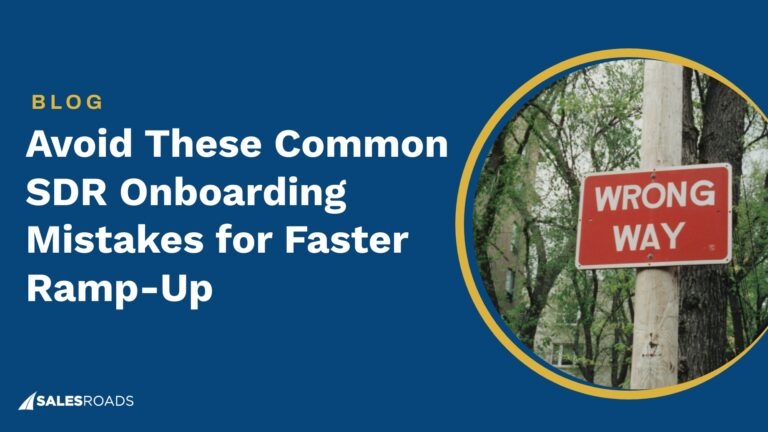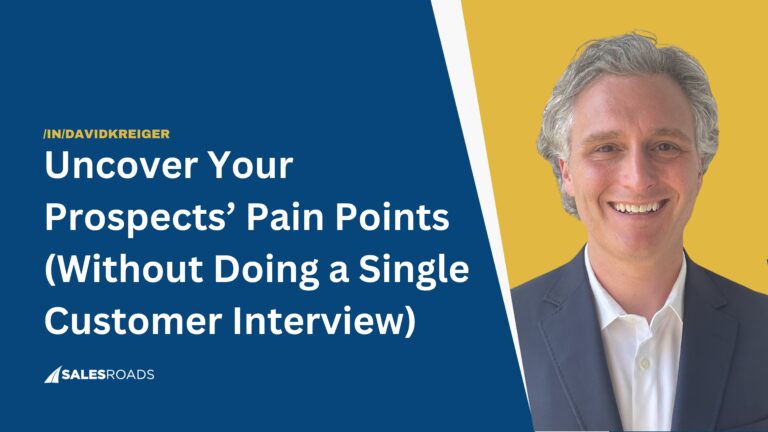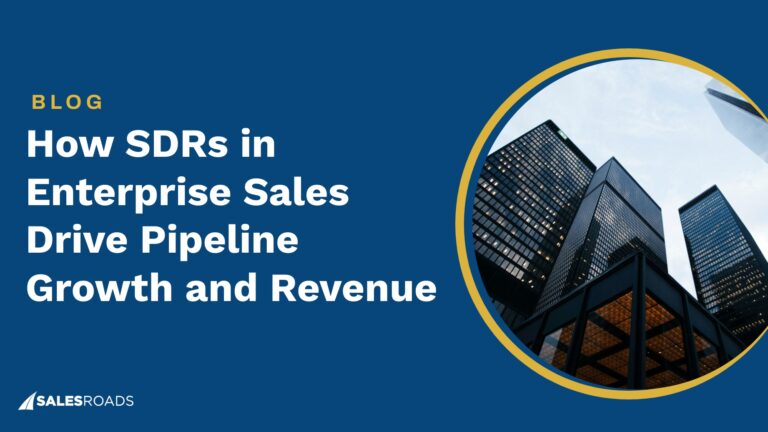Introduction
You’ve decided your organization needs to generate new business. Maybe you’re trying to launch a new product, expand into a new market, or just need to your quota now. Either way, you need to generate new opportunities and don’t know where to start.
First, take a deep breath and know you’re not alone. Many organizations struggle to keep their pipeline full of new customers and although it may seem daunting, this article will guide you through everything you need to get started.
So with that said, let’s dive into the first step in generating new business: Finding Leads.
What is a Lead?
Before we can discuss how to generate new leads, we first need to define what a lead is. This definition may change depending on who you ask, but for the purpose of this article a lead is defined as having two parts:
- A person or organization that you think would benefit from your product/service.
- This person or organization fits your ideal customer profile.
Easy enough, right?
What is Lead Generation?
Unfortunately, the confusion around what a lead is extends to the term lead generation as well. A Google search for the keyword “lead generation” will turn up results for Facebook ads, CRMs, data companies, and yes, lead generation agencies.
The definition of lead generation varies greatly depending on the source and the service they offer. At SalesRoads we see lead generation as the process of identifying, qualifying, and contacting prospective customers who are interested in your product or service.
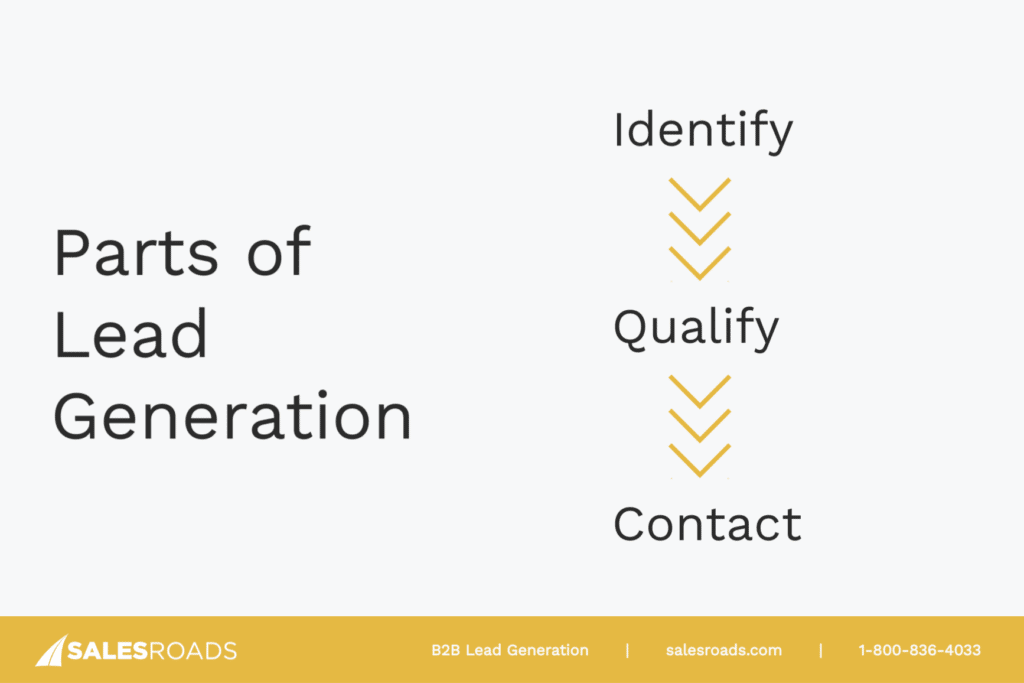
To help your understanding – let’s break that definition down a little further.
- Identifying leads is all about generating a list of potential customers to contact. The emphasis here is on creating a sufficient number of prospects to chase. If you’re always creating new lists, it can be hard to accurately track the effectiveness of your outreach and decide where to invest more time. The exact number of leads you need before beginning to qualify them depends on the length of your sales cycle, scope of work, and bandwidth to pursue them.
- Qualifying leads is all about figuring out which leads are worth pursuing further. Your time is finite so you don’t want to waste time calling businesses who can’t afford your product. Qualifications can be hard or soft – meaning they can be a preference, or they can be absolutely necessary.
- Contacting leads is all about getting your foot in the door. It’s great if you’ve identified a list of 1,000 companies you’d like to work with, but if you don’t know how to reach your customer it doesn’t matter much. Likewise, you’ll want to understand who within an organization is your target prospect. Calling the IT department about your new SaaS marketing solution probably won’t yield great results, but a direct line for the marketing manager might.
With this in mind, you’ll want to start thinking about what types of businesses you want to work with so you can find options for pursuing them (it’s hard to prospect new business if you don’t know who you’re looking for). This process is formally known as creating an Ideal Customer Profile.
Creating an Ideal Customer Profile
Although countless books have been written on the subject, building an ideal customer profile is a vague, often difficult process but is one that every business should undertake. Your ideal customer profile is going to guide every decision you make from here on out, so it deserves your upmost attention. It is also something you should revisit frequently as your business and market conditions change.
Step One: Identify Your Best Customers
Think long and hard about your best customers, but don’t just think about who paid you the most money. Although the average deal size should be a part of your ICP, you’ll want to consider all the factors that make your customer ideal.
You should be considering things like how long they have been a customer, how easy they are to work with, how much they benefit from your product, what verticals they work in, and how they came to be your customer. Imagine you could clone 3-4 customers. Who would you like to work with over and over? Only you know who your best customer is, but these questions should be enough to get you thinking.
It goes without saying, this step is only applicable to businesses that already have some customers. If you just started a new business and don’t have any customers to analyze, find a handful of businesses you think could be ideal customers and use those as your subjects for the next step.
Note: Steps Two and Three, Analyze and Interview, are somewhat interchangeable. You may find your analysis opens more questions than it answers, and you may find that interviewing your best customers informs your analysis. It is perfectly fine, if not encouraged, to flip between these two portions but we recommend starting with an analysis.
Step Two: Analyze Your Best Customers
When conducting the analysis portion, start by studying your 3-4 best customers using available data. Utilize any internal and publicly available information like revenue size, total number of employees, average deal size, customer longevity, and anything else you think is relevant to your customer profile.
To give you an example, at SalesRoads we consider the geographic footprint of potential clients when identifying our ideal customer. We’ve found that companies need to have a regional footprint in at least three states to have enough target prospects to truly benefit from our service. Although geographic footprint is important for us at SalesRoads, a SaaS CRM company probably doesn’t care how many states you work in. This theoretical CRM company probably does care how many employees you have and how many of those employees would need a license to use their product. To round out the example, employee size really isn’t important for us when determining if a client is a good fit. At the end of the day, only you know which factors are truly important for identifying an ideal customer.
Regardless, write down everything you know about your 3-4 best customers and move on to the next step.
Step Three: Interview Your Best Customers
At this juncture, you should have some hard metrics on what your best customers look like. Now reach out to those customers and ask them if they would be open to an interview (if they don’t say yes, they might not be your best customer)!
Before sitting down for an interview think about what information you can’t gleam from available data and center your questions around that. Examples might include:
- What was the reason you decided to invest in a solution like the one we offer? (e.g., what was the issue you were trying to solve)
- How did you find our service?
- Why did you choose our service over other solutions you looked at?
- Why do you continue to use our service?
- Is there anything you would change about our product?
- How many people are involved in the decision-making process to purchase our product?
- In what ways is our service helpful to your organization?
For example, at SalesRoads, we see our ideal customer as a sales executive or organization who doesn’t have the time or resources to effectively manage an inside sales team. We also like to see a client who is looking for a long-term sales partnership, not just a short campaign to hit their immediate goals. As we alluded to earlier, it doesn’t mean we won’t take a shorter campaign, but it’s not our ideal customer. To flesh out this information we asked some of our best clients:
- What led you to work with us originally? (lack of time/resources & need to rapidly increase sales)
- Why do you continue to work with us? (a true sales partnership)
- How many people we’re involved in deciding to contract our services? (informs our sales cycle)
Once you have an idea of the types of companies you would like to work with and what types of stakeholders to target within those organizations, you’re ready to start compiling a list of prospects to chase!
Types of Lead Generation
We’ve already touched on the lack of consistency surrounding the lead generation vernacular, so you probably won’t be surprised when we tell you that methods around lead generation are also convoluted. To make things easy we’ve broken down lead generation into two buckets. Let’s take a look together.
- Inbound Lead Generation is about making yourself visible. This includes activities such as search engine marketing, social media marketing, content marketing, and more traditional channels such as television, radio, and print. As the name suggests, you’re trying to get yourself in front of customers and pique their interest, so they contact you organically.
- Outbound Lead Generation is about making yourself heard. Outbound lead generation strategies include trade shows, offering referrals, outbound social, targeted email, and cold calling. The strategy with outbound lead generation is oriented towards proactively reaching out to your target prospects and starting a dialogue. This strategy is closely aligned with sales.
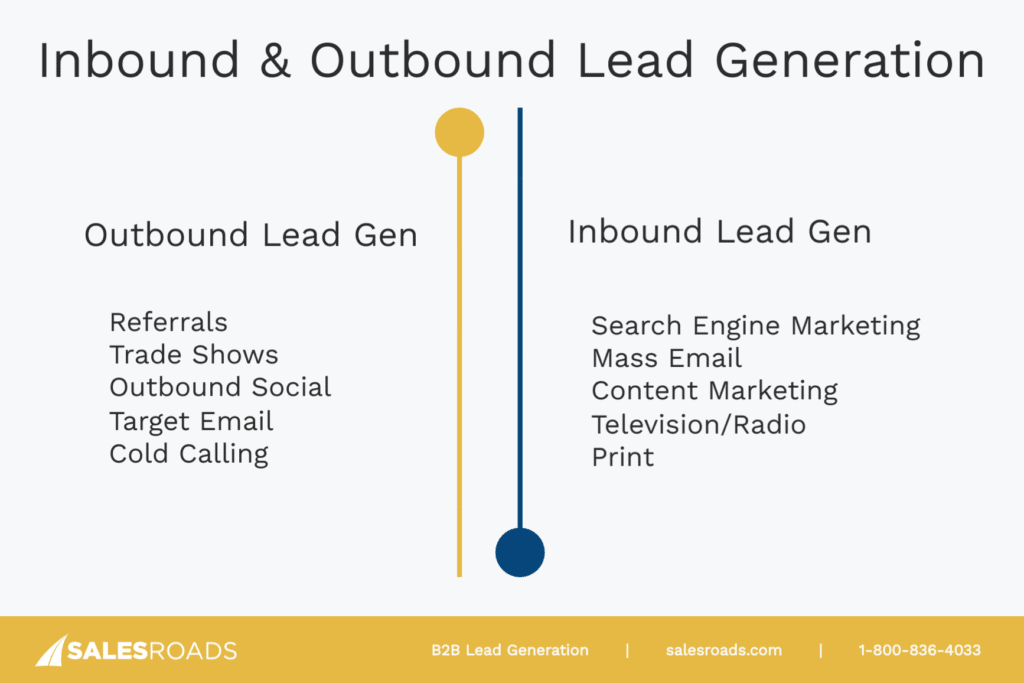
With the emerging popularity surrounding digital channels you might be thinking, “perfect, I’ll start a blog and wait for all that sweet business to roll in!”
Wrong!
In no way are we suggesting you neglect inbound channels. Creating a stream of inbound leads is one of the most valuable endeavors your business can undertake. It is also one of the hardest things to nail down in practice and is an investment in every sense of the word. People aren’t going to start buying your product because of a couple of social media posts, no matter how funny they are. We’ll explore inbound lead generation techniques later in Part Four of this series, Scaling Sustainable Growth.
The reasons we suggest focusing on outbound lead generation first is multi-faceted, but to summarize quickly: inbound lead generation requires a deep understanding of your most effective messaging and this takes time to develop. You could spend countless hours writing blog posts and thousands of dollars on ads with nothing to show for it.
Compare this to outbound lead generation where the goal is to engage live people, and it’s easy to see how the ability to pivot mid-conversation and read social cues is a major advantage in terms of message refinement. Outbound lead generation also has the advantage of being inherently linked to sales.
Business now is better than potential business later, and any good conversation has the chance to turn into an immediate purchase. As a bonus, you’ll get live feedback on the challenges your prospects face regarding your solution.
Lead Generation Services
If you’re reading this article, you might be interested in starting your own lead generation operation. But if you’ve decided that it all sounds like too much and you’d rather just have your team call pre-qualified leads, there are options available. At this point it should be no surprise that the scope and quality of lead generation services vary widely, but here are a couple of different types of services you’ll come across.
- Simple List Building – many data companies sell prospecting lists under the guise of lead generation. Although purchasing a list can be an effective way to get yourself off the ground, these lists often need to be “cleaned up” before they can be used (more on that soon).
- Inbound Lead Generation – is often just another term for marketing. Many companies will run online ads and send you the data. This can be an okay option if you’re looking for an economic solution, but these services have the same problem as list builders; the data often needs to be cleaned and you don’t know if they’re qualified yet.
- SalesRoads Opportunity IQ Lead Generation – at SalesRoads we offer a unique type of advanced lead generation. Because we believe in forming sales partnerships that are for the long-term benefit of both parties, we start our process by helping you identify a list of prospects that fit your ICP. We then call the prospects and qualify them through a series of questions before asking them if they would be interested in learning more about your product/service. You receive all the data we collect to inform prospecting decisions, but more importantly, your team is connected with prospects who have expressed an interest in your product and want a follow-up!
Our clients tell us that our unique approach to lead generation returns highly qualified prospects that are easy to engage and result in profitable opportunities. If you would like to read some case studies or would like to schedule a meeting to discuss how we can help you identify, qualify, and contact new leads for your business, visit our website at salesroads.com/client-success.
All that said – you came here to learn how to create leads for yourself, so let’s get started on creating an outbound lead list!
Creating an Outbound Lead List
Generally speaking, you need to identify a list of businesses and contacts that fit your Ideal Customer Profile before you can begin to contact and qualify them.
Our recommendation is to purchase a list of businesses and contacts and then supplement that base list with manual research and any existing contacts you have. There are numerous online resources for purchasing lead lists and we’ve included some below.
- ZoomInfo – Established and credible data company. More expensive than other solutions.
- Crunchbase – Mostly venture-backed start-ups.
- Discover.org – Owned by Zoom.
- Seamless.ai – the only AI-powered search engine built for B2B leads. They offer a free trial and are a great cost-effective alternative to Zoom.
- SalesIntel – SalesIntel is a top provider of accurate and affordable sales data. They have over 4 million human-verified contacts, resulting in 95% data accuracy, plus their chrome extension is completely free.
Which service you want to use is dependent on several factors including the number of leads needed, your budget, and ICP. If you really need to understand how much funding your prospect has, a solution like Crunchbase is a good choice, although Zoom also has this functionality and is always acquiring new capabilities as the competitive landscape grows.
If funding isn’t as important as finding a cost-effective, all-around solution, we recommend a product like Seamless or SalesIntel. Both solutions also have the advantage of integrating with LinkedIn, which can be incredibly handy when you go to scrub and supplement your base list in the next section.
Prices for a list can run anywhere from a couple hundred to tens of thousands of dollars depending on the service and size of your list. Once you have a list of leads that fit your ICP, you can begin to scrub and supplement that base list with manual research.
Scrubbing and Supplementing Your Base List
After purchasing a list you’ll inevitably find that some of your lead records contain inaccurate or incomplete data. Before you load these leads into your CRM, it’s probably worth going through each record and scrubbing out any unhelpful records. A situation where you might just decide to scrub the lead is when you come across a record that obviously does not fit your ICP. If you provide IT support for SMB then it probably doesn’t make sense for you to target a huge multi-national corporation like Microsoft which certainly has an internal team, but if your core customer is listed on the Fortune 500, call away! You will want to strike a balance between removing too many records and eliminating wasted time pursuing dead-end leads.
Once you’ve taken out the obviously poor fits, you can begin to supplement the incomplete records with manual research.
Depending on where you found your list you may need to supplement it with different sets of information. For example, Crunchbase makes it very easy to find companies that fit certain parameters such as recent funding or executive profiles, but they do not provide contacts for that company. You may decide to look up contacts at those companies using ZoomInfo, but even then, you’ll inevitably have a handful of inaccurate or outdated emails, phone numbers, or titles. We’ve included some resources for you to use when supplementing your list.
- Email Grabber – scans websites and can help you find missing emails
- LinkedIn – great for findings contact names and titles within an organization. Can be paired with SalesIntel or ZoomInfo for more capability
- Rocktreach.co – identifies email structures within an organization allowing you to make informed guesses on where to reach your contacts
- ZoomInfo – Covered above, solid service but expensive price tag
- Automata – an amazing tool for finding complex, specific, or unique leads and associated info. For instance, if you need to find the contact info for an individual that has sales experience, was promoted in the last year, and works in the automotive industry, this is your solution.
When all else fails you can use the following process for rounding out your records.
- Take the business name to LinkedIn and find a person with your target title.
- Go to that company’s website to find their main phone number and call the front desk.
- Finally, tell the receptionist that you’re looking for the contact/title you found on LinkedIn and ask to be transferred.
You may or may not connect with your prospect, but if you do it right you should be able to determine if your contact still works there if they are the person you want to reach, and possibly how to reach that person.
Putting It Together (The Perfect Calling List)
Over the last few sections, we’ve listed no less than nine different resources for finding prospecting information, as well as different use cases for each one. During your list building and research phase, you are certain to find tools that work better for your business, but also others that fall flat. Unfortunately, there is not a magic mix of resources that creates a perfect calling list.
Well, maybe there is a perfect mix, but the secret ingredient isn’t an ingredient at all; it’s just good ol’ fashion elbow grease.
At SalesRoads we strive for 98% list proficiency. This requires a concerted effort, to the tune of hundreds of hours of work from an entire team of data and research specialists. Although you might not have a dedicated Data Team, you still want to do your best impersonation. Some steps our Data Team takes to ensure such high proficiency include:
- Manually Verifying All Contact Info Including Name, Direct Phone, Email, Title, and LinkedIn Profile Link
- Manually Verifying Business Info Including Address, Phone, Current Employees, and Website Link
- Aggregating All of the Above Data into a Single Data Source
- Checking Multiple Resources for Records or Fields that are Still Missing
- Verifying Email Validity Through a Tool Like ZeroBounce to Reduce Bounce Rate
- Building Sophisticated Integrations to Ensure Data Hygiene Across Tools
In the video below, I talk about SalesRoads’ magic formula for having a great database; multiple external data sets + internal data sets compiled through years of industry experience.
At any rate, invest as much time here as possible, it will save you a lot of time in the long run. After all, you don’t want to waste time sending emails to accounts that are no longer active, or worse, spending weeks pursuing a prospect that has recently retired.
Testing and Optimizing Your Lead List
Remember to document the steps you took to create your lead list. Once you begin prospecting with this list, you’ll want to determine what works well and what does not. This will ensure that you are continually improving your lead generation process, not just calling aimlessly.
Although we’ll cover this again in Part Two of this series, Starting a Sales Conversation, proper documentation on the front end is paramount to that effort.
How Long Should Lead Generation Take Me?
We wish we could answer this question with absolute clarity but, just like creating your ICP, only you can really determine what is reasonable for your business. Typically, it is recommended that sales professionals spend about 60% of their time prospecting new clients. Using that as a guideline, we would say that generating a list should take about 25% of that time upfront, with the understanding that more research is likely needed as you begin to prospect off that list.
When you do the math (25% of 60% = 15%), a general recommendation might be around 15% of your total sales time should be dedicated to creating a sufficient list to call on, but again, only you know what is appropriate for your business; and as we mentioned above, the more time you spend creating a perfect calling list, the more time you save in the long run.
If you feel overwhelmed by this process or lack the time and resources to execute it efficiently, visit our advanced account research page to learn how we can help you create a list of high-conversion, qualified prospects who have expressed an interest in learning more about your product or service.
Summary
Congrats on making it to the end, we’ve covered a lot in this article! To help you stay on track we’ve summarized a list of topics we covered for creating a high-performing lead list!
- Create an Ideal Customer Profile
- Types of Lead Generation
- Options for Finding a Lead List
- Lead Generation Services
- How to Clean Your Lead List
- Testing and Optimizing Your List
I Have a Bunch of Leads, Now What?
In the next part of this series, we will discuss how to turn those leads into qualified opportunities. Some subjects we will touch on include:
- Defining an Outreach Strategy
- Creating a Funnel
- Building a Value Proposition
- Getting People to Listen







